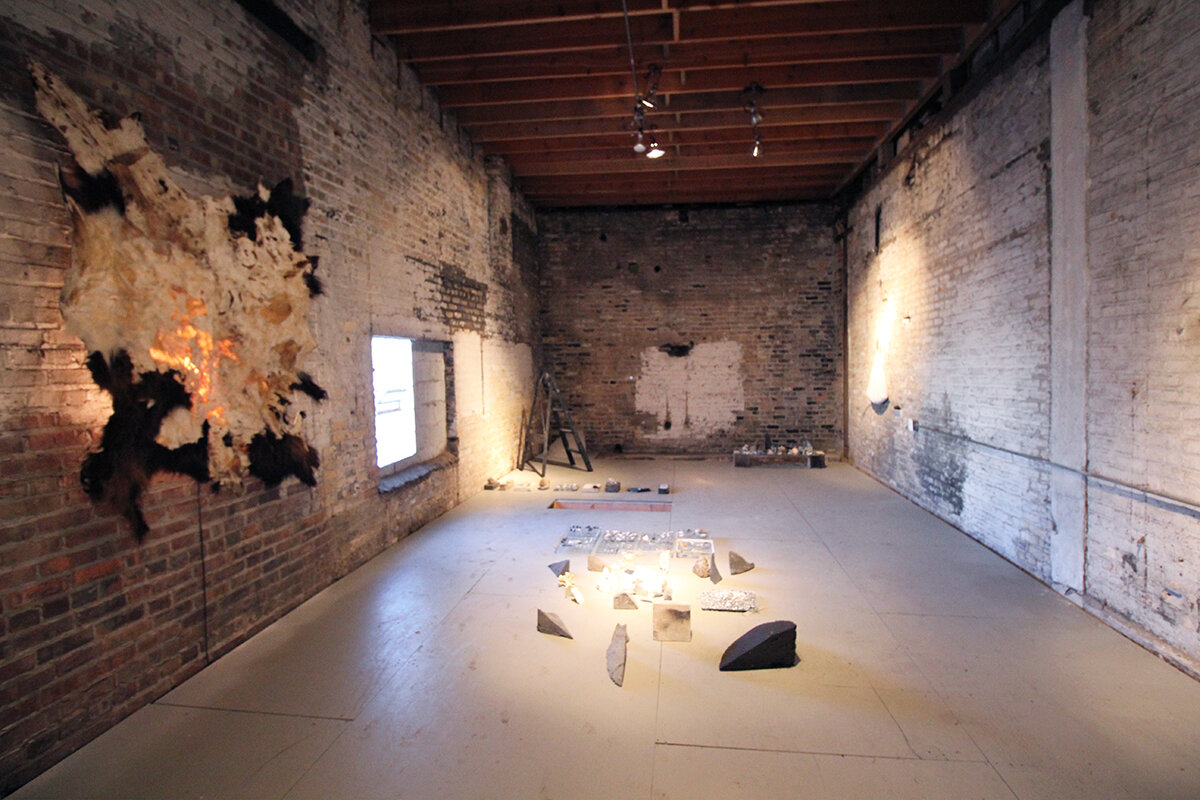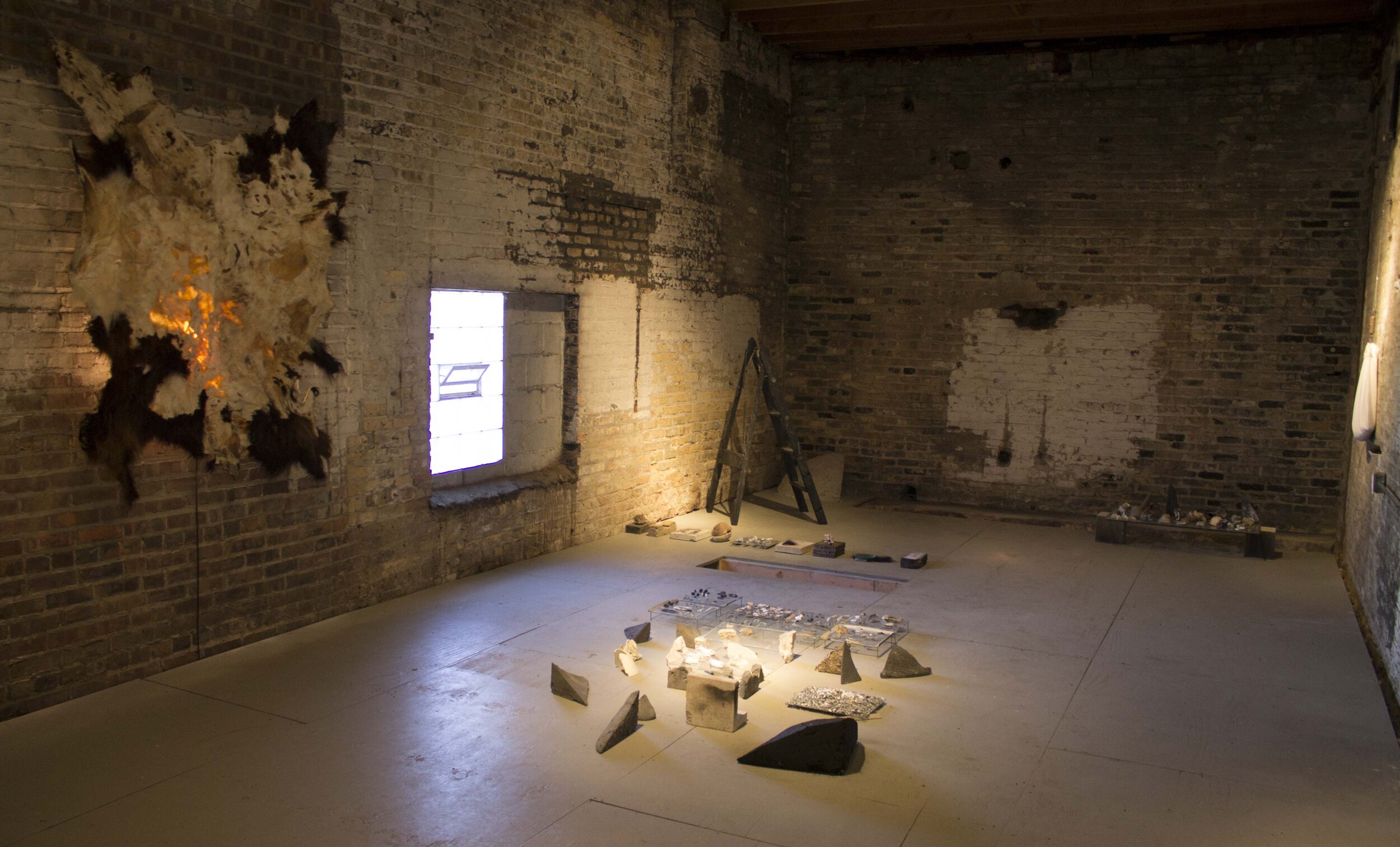
Inherencies
Introduction by Dan Beachy-Quick
+ + +
How repair ruin? Add more ruin in. Burn the nest, burn the feathers, burn the bones. Repeat the ritual. Let fire work its own tool. Let time work its tool, too. These rites are no instruction manual for the making of art. They mark the process of caring for the damage of the human heart, the animal heart, the heart larger than both of those, carried not within the body, but within which the body lives, the heart that is the rooms which house us, heart which is the world. Heraclitus of old says all in fire begins and ends, and the crematory flame must be seen also by its opposite light, that brightness of origins. Fire points both ways at once—to death, to birth. It says life happens in between these extremes, and fire provides the means by which we sustain ourselves, a process in which violence is inherent, in the name of which we nurture our own lives by ending other lives, clothing ourselves in the skins of the animals we eat, sheltering ourselves within the stone we break, the wood we cut down. This isn’t judgment, this honesty. It is that strangest form of care that admits to the violence of life, not to end it, but to find in it what is necessary and what is not, and to the former, to pay honor, not by healing, not by applying poultice or balm, but by caring for the damage of the damage, letting us see it, and quietly acknowledge within ourselves, that we too are alive, and being so hurt and are hurt, harm and are harmed, and this reciprocity is a form of love. In this show there is a sparrow with a dream inside it. The dream is written on paper, and the paper rolled up, hidden in the preserved body of the passerine. The gesture gestures to us all, hinting we bear within ourselves some content not wholly our own. And so we reach the deeper ethic at work in the aesthetic, wholly inseparable from it, as is the ash one with the body from which it comes. What we see in the work is a kind sympathy at work upon objects and architecture, an ongoing care for the structures that bear the burden and gift of the life occurring within them and around them—be it floor, wall, skin, bone, nest, shell. These ruinous materials are our very own matter though seldom do we feel in ourselves the fragility that guards us, not from harm, but within harm, and sense, as Rebecca Beachy insists we must, that we also must protect that which protects us. This isn’t pristine work. It cannot be. As of the burnt deer tooth it reminds us that bite, and ruminant in our own way, begin thinking by virtue of subsisting; and as of the burnt deer hooves, we see too that we are creatures always ready to flee, not from the threat outside us, but the dream rolled up within us, that begs understanding instead of reprieve, that the made-thing is always mortal, and we become human by tending the humus, the ash, the dirt, the bone, the blood.
New Capital Projects
Chicago, Illinois 2015/2016
materials list:
fire-treated animal bones, kiln-fired animal bones: cow, horse, fox, deer, wolf, coyote, bear, otter, varieties of birds, squirrel, rats, armadillo, turtle, pigs, cats, goats, sheep ...
ground eggshells distributed over foundation ground level
wall mortar and spackle mix w/cremated Amish horse bones
bone-dust cement-block castings
ash wedges, cast ash from bone fires
cow, hand skinned and tanned
taxidermy sparrow with dream written and hidden inside
taxidermy duck molded over in birds’ nest mud
birds’ nest window ledge
bone shelf with taxidermy bird molded over in birds’ nest mud
mud wedge, cast from New Capital basement mud
bird’s nest, found in New Capital chimney
oceanic rock concretions
fossil w/ paper-wasp nest
bone column from road-kill cremains
concrete blocks, pulled from fire pit
magnifying lens
small concrete wedges, nails
paper-wasp paper wedge
ground-eggshell cartons cast into wedge
pigeon spikes
architectural salvage glass
bricks pulled from New Capital foundation
cardboard platform, wax dipped
charred ladder
charred window frame
heat lamps
weighing scales

















